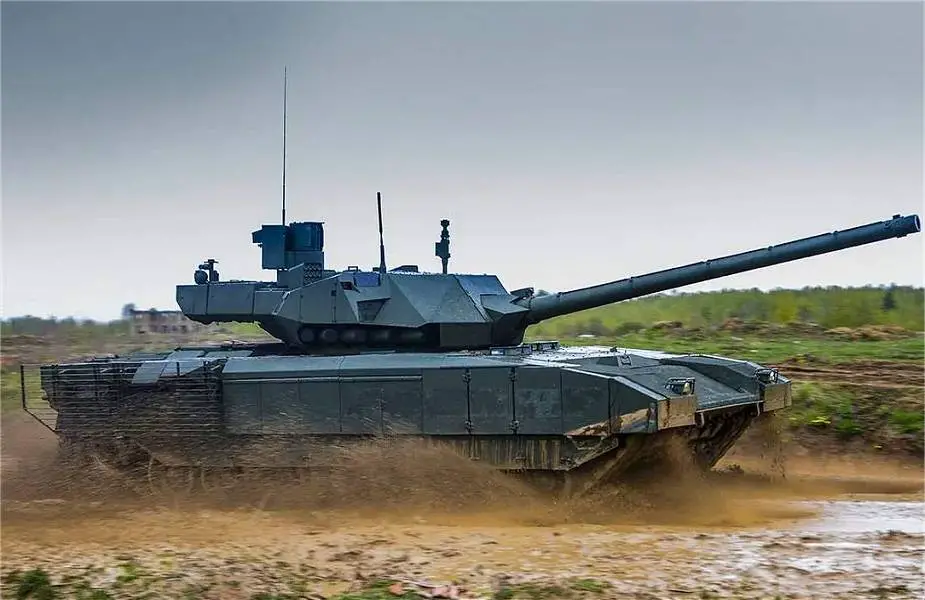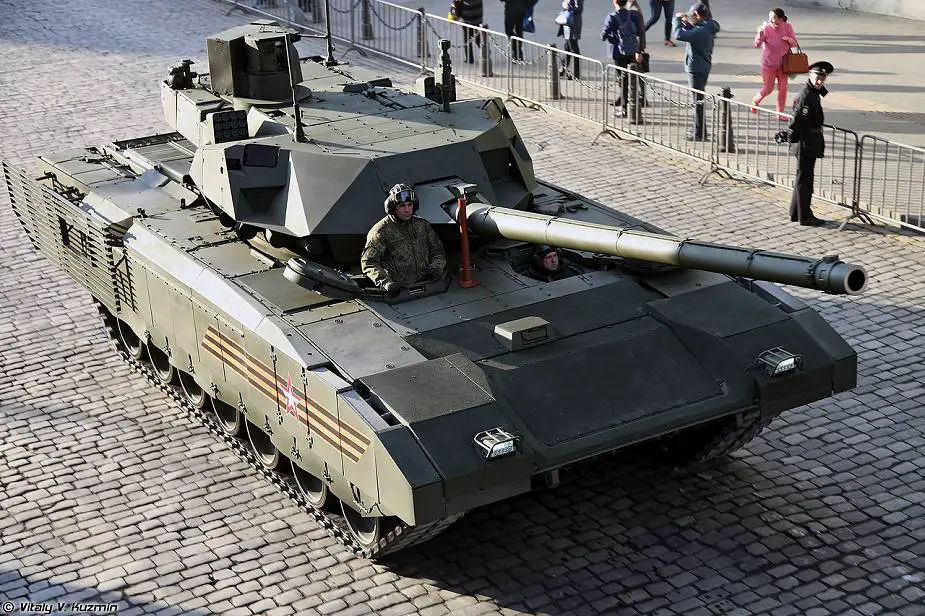According to news published by the Russian Press Agency RIA on April 25, 2023, relayed by Reuters, in a recent development, Russia has started employing its advanced T-14 Armata Main Battle Tanks (MBTs) to target Ukrainian forces. However, these tanks have not been involved in any direct attack missions thus far.
Follow Army Recognition on Google News at this link

The T-14 Armata is the latest generation of Main Battle Tank developed and produced by the Russian defense industry. (Picture source VZ.RU)
According to the Russian Press Agency RIA, the T-14 Armata tanks have been equipped with additional armor on their sides, and their crews have undergone "combat coordination" exercises at training facilities within Ukraine.
On February 14, 2023, the Army Recognition editorial team reported that Russian soldiers had started training with the T-14 Armata tank for possible deployment to Ukraine. Drawing on information from Russian sources, the deployment of T-14 Armata tanks in Ukraine is intended to counteract the Leopard 2A6, Challenger 2 and M1A1 Abrams tanks, which have been pledged by the United States and European nations.
The T-14 Armata is a next-generation main battle tank developed and designed by Russia's Uralvagonzavod, a leading tank manufacturer. The development of the T-14 began in the early 2010s as part of the Armata Universal Combat Platform, aiming to create a versatile and modular system that could be adapted for various combat roles.
The T-14 Armata features a revolutionary design compared to its predecessors, such as the T-72, T-80, and T-90 tanks. One of the most significant differences is the unmanned turret, which houses the primary weapon and an autoloader. The three-person crew is situated in an armored capsule at the front of the hull, separate from the turret. This design choice increases crew survivability and allows for a lower overall profile.
Another innovative aspect of the T-14 Armata is its extensive use of advanced electronics and automation systems. The tank is equipped with a sophisticated fire control system, multiple high-resolution cameras, and advanced sensors, providing the crew with a comprehensive understanding of their surroundings and enabling rapid target acquisition.
The T-14 Armata also emphasizes modularity, allowing for upgrades and customization depending on the mission requirements. This approach enables the tank to be easily adapted for various roles, such as reconnaissance, infantry support, or heavy assault.

Russian army T-14 Armata MBT Main Battle Tank. (Picture source Vitaly Kuzmin)
The T-14 Armata was first publicly unveiled during the 2015 Victory Day Parade in Moscow. Since then, it has undergone extensive testing and trials, with plans to gradually replace Russia's older tank models as part of the country's military modernization efforts.
The T-14 Armata is a cutting-edge main battle tank that stands out due to several unique technologies and innovations. Key features include an unmanned turret, allowing for a lower profile and enhanced crew survivability. The primary weapon and autoloader are housed in the turret, while the crew is protected in an armored capsule at the front of the hull.
This armored capsule safeguards the three-person crew separately from the turret and ammunition storage, significantly increasing survivability in case of a hit or ammunition detonation. Additionally, the T-14 Armata is equipped with the Afganit Active Protection System (APS), designed to detect and intercept incoming projectiles using radar and other sensors, offering an extra layer of protection.
The advanced fire control system enables rapid target acquisition and improved accuracy by integrating data from multiple sensors, such as high-resolution cameras, thermal imagers, and laser rangefinders. The T-14 Armata's modular design, based on the Armata Universal Combat Platform, allows for easy upgrades and customization for various roles, including infantry support, reconnaissance, and heavy assault.
With a 1,500-horsepower diesel engine, the T-14 Armata can reach speeds of around 56 mph (90 kph). Its advanced suspension system and relatively low weight contribute to impressive maneuverability and off-road capabilities. Furthermore, the T-14 Armata is designed to operate as part of a broader networked battle space, integrating with other platforms and sharing data for improved situational awareness and effective coordination among units.
These technological innovations make the T-14 Armata a highly advanced and formidable main battle tank, reflecting Russia's dedication to modernizing its armored forces.
















